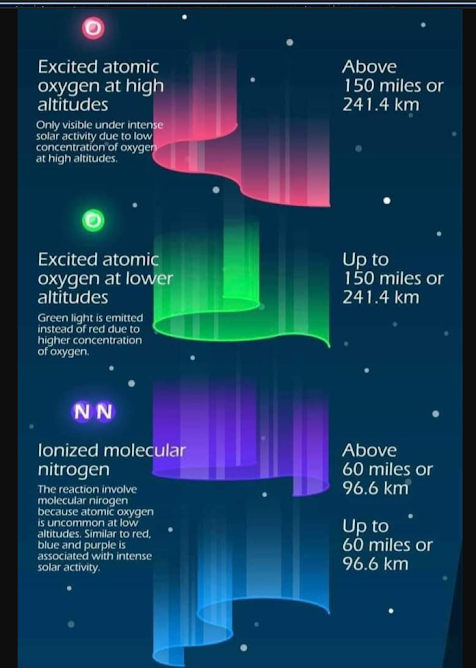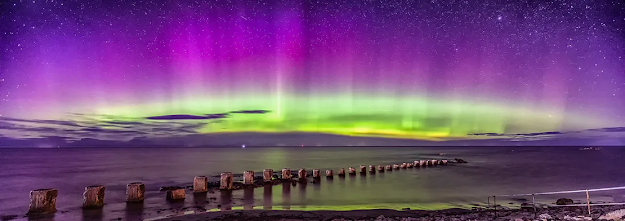 |
| Northern lights, captured in University of Surrey, UK |
Here's a breakdown of what happened and how you might catch a glimpse of the aurora if it continues:
 |
| Northern Lights, Captured in Guildford, UK |
A Solar Storm Lights Up the Night
 |
| An artistic representation of a solar storm. The plasma can be seen launching from the surface of Sun |
A series of eruptions on the Sun's surface unleashed a stream of charged particles hurtling towards Earth at an incredible speed of 900 km/s (over twice the usual!). This "solar wind" collided with Earth's magnetic field, triggering a strong geomagnetic storm and causing the aurora to be visible at lower latitudes than normal, including parts of the UK.
The captivating colors of the Aurora Borealis aren't a random display! They depend on two key factors: the type of gas molecule the solar wind interacts with and the altitude of the collision within the atmosphere.
 |
| The image displays how the color of Aurora is dependent on both the altitude and the type of molecules |
Green Aurora (most common): High-altitude collisions (over 150 miles up) between energetic particles and atomic oxygen create the mesmerizing greenish-yellow glow.
Red Aurora (less common): Collisions with atomic oxygen at lower altitudes (up to 150 miles) cause the red hues, but these auroras are generally fainter than green ones.
Blue & Purple Aurora (rarest): Excited molecular nitrogen, requiring more energy than oxygen atoms, creates these vibrant colors. They're most likely seen during strong solar storms due to the increased energy at lower altitudes (around 60 miles).
Best Places to See the Aurora (if it reappears)
 |
| Image of Aurora Borealis in Scotland |
While the initial sightings occurred on Friday night (May 10th) and continued into Saturday morning (May 11th), there's a chance the aurora might reappear over the next few days:
Prime Locations: Scotland and northern England are predicted to have the best viewing opportunities due to their northerly position.
Beyond the North: The geomagnetic storm might be strong enough for the aurora to be visible across the entire UK, with some luck!
Maximising your chances of seeing the Northern Lights
Seek Darkness: Light pollution significantly hinders visibility. Look for areas far from city lights, ideally in the countryside.
Clear Skies are Key: Clouds will block your view of the aurora. Check weather forecasts for clear skies, especially towards the north.
Patience is a Virtue: The aurora is unpredictable. Be prepared to wait for extended periods and enjoy the clear night sky while you do.
Timing Your Aurora Chase
The recent solar storm's effects are expected to last several days. Here's a timeline to help you plan your aurora viewing:
Friday Night (May 10th): The initial sightings of the aurora occurred.
Saturday Night (May 11th): There's a possibility of further sightings, particularly in the north.
Next Week: Experts suggest the peak auroral activity might occur on Monday or Thursday of the following week.
A Word on Technology and Safety
While the solar storm might affect technology in space and on Earth, the Met Office does not anticipate any disruptions to UK infrastructure. Space weather is constantly monitored, and actions are taken when necessary to mitigate risks.Embrace the Wonder!
The recent solar storm and the resulting aurora sightings were a spectacular reminder of the dynamic forces at play in our solar system. With a little preparation and a dash of luck, you too might witness this celestial phenomenon if the aurora returns in the coming days!


















Woah, I really want to see that in person
ReplyDeleteyes its really a sight to behold
DeleteAmaiz
ReplyDeleteExcellent information
ReplyDeletethank you so much :)
DeleteReally appreciate the information!! One stop destination for every information about aurora indeed
ReplyDeletethank you for the appreciation :) keeps me motivated
DeleteI am hoping to observe it today!!! Kicking off an item from the bucket list!! Hopefully
ReplyDeleteyayyyy! did you get to see it ?
DeleteThe Aurora borealis show looked absolutely out of the world. Seeing Northern lights in UK was just so unexpected. This shows the impact of solar activity on earth. Thankyou so much for sharing this post. Loved it!
ReplyDeleteMore power to you!
much appreciated ! yes indeed they were out of the world , quite literally
DeleteGreat content
ReplyDeleteDon't know if there will be such a big solar storm that India also witnesses some lights 😅
ReplyDeleteI think some parts of Leh were able to see these lights !
Delete